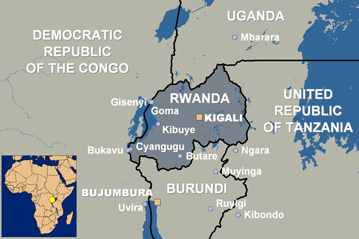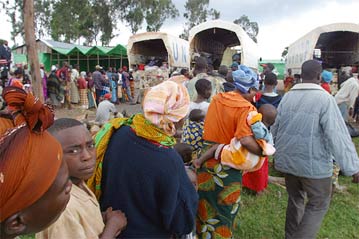
Unit plan for ages 12-14 in History: The Rwandan Crisis 1994
Teaching Tools, 28 February 2007

© UNHCR
Designed by Population and Geographic Data Section in Division of Operational Support
UNIT OBJECTIVES
Knowledge
- To understand the background of events which shook Rwanda in 1994.
- To understand what genocide is.
- To understand the process and reasons which triggered the flow of refugees from Rwanda into neighbouring countries.
Skills
- To practise research skills:
- defining a problem
- seeking appropriate information sources
- identifying relevant information from the sources
- critically analysing the information
- organising the information to answer particular questions
- clear written expression
Values
- To appreciate the importance of moral values.
- To appreciate the importance of respect for others, particularly people different from oneself.
| CONTENT |
TEACHING METHODS/LEARNING STRATEGIES |
|
Where is Rwanda? What are its neighbouring countries? Who are the ethnic groups living in each country? In what proportions were these groups represented in the Rwandan population in 1994?
Overview of the history of Rwanda, focusing on the contributing events and factors that led to the 1994 genocide and the flight of Rwandan Hutu refugees into the neighbouring countries.
|
Introduction: On a wall map of Africa, the students are shown the relative positions of Rwanda and its neighbouring countries, and the inter-national borders which were crossed by refugees fleeing Rwanda in 1994.
On the map on the activity sheet, the students should note each country's ethnic composition prior to the 1994 upheaval, to reveal that international boundaries do not separate the ethnic groups into individual nations.
Development
Students spend class time reading through the resources that outline the historical events. These resources are listed in the next column.
The teacher can check the students' factual understanding with the accompanying comprehension questions.
|
| RESOURCES |
 © UNHCR/H.J.Davies Rwandan refugees on the move in Kisangani, Zaire. Activity Sheet: Rwanda and its neighbours
- Jill Rutter, We Left Because We Had To, (London, Refugee Council, 1996), p. 66-73
- "Rwanda: causes and consequences of the refugee crisis", UNHCR, The State of the World's Refugees 1995: In Search of Solutions (Oxford, OUP, 1995), p. 32-33.
- "Great Lakes Chronology", Refugees, no, 110 (Geneva, UNHCR, 1997), p. 8.
|
|
| CONTENT |
TEACHING METHODS/LEARNING STRATEGIES |
|
Moral issues raised by these events:
How is it possible for a nation to descend into such a level of barbarity? Who is responsible?
|
Teacher-guided, structured discussion, followed by individual writing exercise, answering the two questions opposite.
|
| RESOURCES |
 © UNHCR/L.Astrom The camps in Goma, Zaire were overcrowded. Poor sanitation and lack of clean drinking water led to diarrhoea and cholera, and many of the victims of the diseases were children. Jill Rutter, We Left Because We Had To (London, Refugee Council, 1996), p. 75-77
|
|
|
CONTENT
|
TEACHING METHODS/LEARNING STRATEGIES
|
|
The return of law and order has provided secure and stable conditions for the return of refugees to Rwanda who now face the challenge of rebuilding their lives in their own country.
|
Students prepare short presentations about the political and social situation in current Rwanda which has made possible the return of refugees to their home country.
|
|
RESOURCES
|
 © UNHCR/B.Heger Rwandan returnees unloading their belongings and getting registered at the UNHCR transit centre in Byumba, Rwanda. Rwanda Returnee News, no. 1 [PDF, 355Kb]
Rwanda Returnee News, no. 2 [PDF, 220Kb]
Rwanda Returnee News, no. 3 [PDF, 283Kb]
|
|




